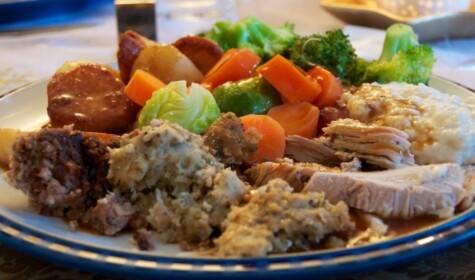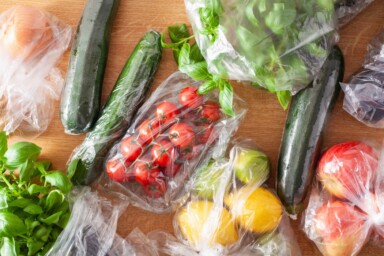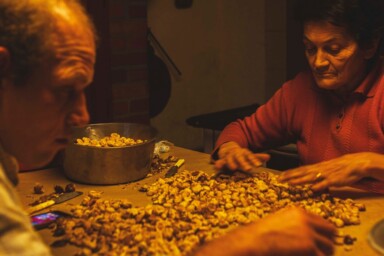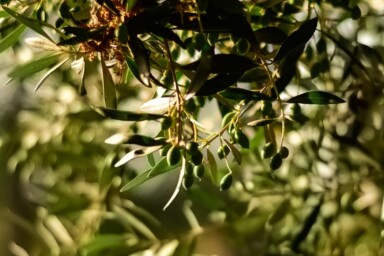Christmas has become a time of hyper-consumerism and extreme overconsumption. As a result, it can be a frustrating time of year for those concerned about the impacts of what we eat on our health and the environment – but it doesn’t have to spark an existential crisis.
In order to get a grasp on what a sustainable, ecologically conscious Christmas meal might look like, we’ve taken a look at the ecological footprint, environmental implications and general sustainability of some classic Christmas dishes.
Parameters for a festive reflection
It’s worth looking at benefits beyond simple production statistics to consider things like the ecological footprint of food production, nutrient uptake and transfer through the food chain, protection of biodiversity, human health, food miles and the negative consequences of long supply chains.
For starters, let’s lay out what we mean by Christmas ‘classics’, taking a look at what we eat for Christmas dinner, why we eat it and whether we should be eating something else instead.
Meat in the middle
Meat has always been the centre of attention on Christmas Day and with more and more meat-free alternatives and meat-slamming documentaries popping up these days, the turkey or ham in the middle of the Christmas table is bound to attract at least one or two comments about what meat’s role is in the climate emergency. However, evaluating the ecological footprint of your Christmas dinner is not as easy as simply cutting meat out or calculating its emissions.
To begin with, not all meat is raised equally. The staggering statistics about the environmental costs of global meat production – that it accounts for about 15-18% of total greenhouse gas emissions, or that it takes nearly 20,000 litres of water to produce 1kg of meat protein – are largely skewed by a few huge, high-intensity livestock industries (beef in particular). These industries, for example, usually focus on a few high-yielding commercial breeds that live in cramped quarters, are given antibiotics and hormones, and are fed on often imported, pesticide-laden, genetically modified feed crops.
Conversely, more sustainable livestock farming practices can have a much lower ecological footprint. Especially those that are grazed on perennial pastures, which store carbon and may be crucial in helping to mitigate the effects of climate change. In many cases, they also play a positive role in the health of their local ecosystem by providing vital fertiliser for the soil and breaking the soil surface with their hooves to allow the re-sowing of wild seeds.
With this broad difference in mind, let’s take a closer look at the two meaty titans at the centre of the Christmas dinner table…
Turkey
Turkey was introduced to Britain from North America in the early 16th century, and it first appeared on Christmas menus as early as King Henry VIII’s royal Christmas feasts in the 1520s. However, it remained an expensive, extravagant Christmas treat until the turn of the 20th century. Since then, it has undergone an American-led process of industrialisation and intensification that, within a century, has taken turkey from being one of the most expensive meats on the market to one of the cheapest.
Ham
Eating ham at Christmas is said to have been established as an English tradition by at least the Middle Ages. It arrived, through Germanic pagan traditions, from Norse mythology, in which a boar is considered a good omen in battle and for a good harvest. In medieval Norse culture, therefore, roasted boar was offered as a sacrifice to the god Frey during the winter months.
Choosing the right meat
According to the UK Soil Association, over 90% of turkeys raised in the UK are farmed intensively. Additionally, given the incredibly high demand over a short period around Christmas, many UK suppliers import frozen turkeys from abroad.
Likewise, pork products are frequently listed among the foods with the worst environmental footprint (including one scientific report tracing the carbon footprint of different types of sandwiches, which determined that four of the top five worst offending sandwiches included pork products). This is largely due to the damaging toxic effects of manure management and run-off from industrial pig farms on land and waterways, in addition to carbon and methane emissions.
In other words, it’s clear that, if you don’t know where your turkey or ham is coming from and how it was grown and you can’t find out, the ecological footprint is sure to be bad.
The good news is that there are farmers in the UK producing both turkey and pork products in a slower, better way – for example, using heritage breeds, pasture grazing, and hanging the meat to enhance flavour and marbling. In 2017, the National Farmers Union ran a #BuyMyTurkey social media campaign and launched their festive Turkey Finder, an online resource designed to let British consumers buy their turkey from one of over 250 farms mapped around the country. Although not all farms adhere to the highest ecological standards, at least being able to go and buy directly from the farmer lets consumers know (and see) what they are buying.
Alternatively, if you’re looking to try something new this year, why not take some inspiration from the past?
Venison and game were a ubiquitous item on British Christmas dinner tables throughout Tudor times. Today, populations of wild animals like rabbits and deer need to be controlled in some areas of the country, in order to prevent population explosions and to preserve forests and natural habitats. You can often source sustainable, culled venison or rabbits for Christmas from certified landowners, gamekeepers and local butchers.
Beef, which until the invasion of the turkey in the 19th century used to be the Christmas standard for many British families (especially in the north of England), is another option. Despite the well documented impacts of intensive cattle farming, eating beef can still be an ecologically sound Christmas alternative if sourced from good producers.
However, British lamb, hogget and mutton, is probably the most sustainable meat to eat from a UK perspective. Britain has 60 native sheep breeds that are largely raised traditionally and sustainably on the nation’s extensive grasslands. Like beef, their presence on the land helps regenerate soils and sequester carbon. It is also nutritionally rich – it provides all nine essential amino acids, which supports the body’s growth and maintenance. Lamb, hogget and mutton all vary in flavour depending on breed and the variety makes for some very good eating.
Some other ecologically imbalanced Christmas favourites
As harmless as they may seem, these festive comforts can also increase the ecological footprint of your Christmas meal.
Christmas Pudding
Beginning in the Middle Ages out of ‘frumenty’ porridges and newly available (since the Crusades) exotic spices like nutmeg, cloves and cinnamon, British Christmas pudding has developed over the centuries to be almost inextricably entangled with colonisation, globalisation and food miles. This reached a peak in 1927, when the Empire Marketing Board published an extremely popular Christmas pudding recipe, in a seemingly desperate attempt to boost trade with the colonies; the recipe specifically included Zanzibar cloves, South African raisins, Australian currants, demerara sugar from the West Indies, brandy from Cyprus, and even minced apples from Canada.
Satsumas, clementines and mandarins
Whatever citrus your family prefers to stuff at the bottom of a stocking or arrange in a bowl on the table, this Christmas tradition was most probably inherited through a 16th-century Dutch folk tale in which Saint Nicholas, hearing of a poor, dying man and his three daughters, throws three sacks of gold coins into their house during the night. The sacks happen to land, according to some tellings, in the girls’ stockings, which were hanging by the fireplace. The golden Christmas oranges we get today are said to represent these sacks of coins – although the tradition was really solidified in the 19th and early 20th centuries, when exotic fruits in the UK were truly a rarity and a genuine Christmas treat.
Today, most Christmas citrus in Britain comes from Spain. Unfortunately, Spain’s intensive citrus-growing regions are running a massive ecological deficit as they are reliant on external inputs (like chemical fertiliser and pesticides), and the switch from traditional methods to mechanical monocultures is causing significant soil degradation. Therefore, easy-peelers are, unfortunately, not the most ecologically friendly Christmas treat.
While it might not sound as sexy as an Andalusian orange, apples offer an alternative. In Britain, they were once as exotic and revered as citrus fruits. Native to Central Asia, apples have adapted to the UK’s various soils and climates as well as any other fruit, with many local varieties being harvested and matured well into the festive season. Dig a little deeper beyond the polished, shiny supermarket kind and you’ll discover a cornucopia of different British apple varieties.
Chestnuts
Although on the surface a safe, seasonal British favourite, chestnuts are a silent assassin in terms of calculating your Christmas dinner’s ecological footprint. If you have a chestnut tree or make the effort to find one in the wild from which you can forage, then great! Chestnuts generally fall around the UK in late autumn, so they are perfectly seasonal. However, if you buy chestnuts from the shop, you’re almost certainly getting something grown in Spain or China.
Why not try a native British hazelnut or Kentish cobnut as a stuffing-filler or roasted nibble this year instead?
The safe bets for seasonal feasting
You don’t have to change the Christmas menu entirely in order to eat with an ecologically clear conscience this year. Luckily, a few standard Christmas favourites already pass muster.
Stilton or better yet, Stichelton
The final month of the year apparently accounts for nearly half the annual sales of the six official Stilton producers in the UK who, through the EU Protected Designation of Origin legislation, have to be located in the historical regions of production: Nottinghamshire, Leicestershire and Derbyshire. The good news here is that, given the PDO regulation, it’s impossible to buy Stilton that has come from outside of the UK, and there are prescribed standards of manufacturing that these producers have to meet.
The bad news, however, is that these rules for production were laid out by the largest Stilton producers, and some small-scale producers have been pushed out as a result. The best example is the requirement for Stilton to be made with pasteurised milk, which means that Stichelton, which is made by traditional methods using raw milk from a single herd of pasture-fed cows, cannot be called Stilton. If you want to make a small, ecological-political statement this Christmas, opt for Stichelton instead of Stilton.
Brussels sprouts, parsnips, carrots and potatoes
Luckily, all the delicious veg we associate with Christmas can be grown with a neutral or even positive ecological footprint across the UK during the festive season! Just be sure to check the country of origin or, better yet, buy direct from farms, markets or reliable organic suppliers. It’s easy to find suppliers all around the country through the Soil Association website.
Don’t be scared to try something new
Whether you want to go meat-free, traditional, or carve your own course this year, the underlying feature for an ecologically conscious Christmas dinner lies in traceability. Usually, this incorporates locality, seasonality and organic production, but it doesn’t have to. Ask questions, shop around, trace the product back to where it was produced and see if you’re happy with the way it was made.
That way, you should be happy with the meal you put on the table alongside your loved ones, safe in the knowledge that it didn’t cost the Earth.







